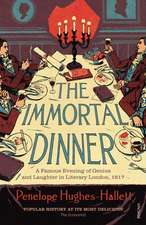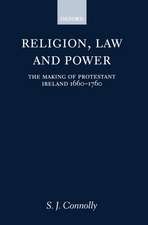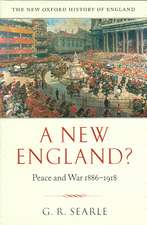Images of Youth: Age, Class, and the Male Youth Problem 1880-1920
Autor Harry Hendricken Limba Engleză Hardback – 12 apr 1990
Preț: 323.14 lei
Preț vechi: 467.31 lei
-31% Nou
Puncte Express: 485
Preț estimativ în valută:
61.83€ • 67.38$ • 52.10£
61.83€ • 67.38$ • 52.10£
Carte tipărită la comandă
Livrare economică 12-18 aprilie
Preluare comenzi: 021 569.72.76
Specificații
ISBN-13: 9780198217824
ISBN-10: 019821782X
Pagini: 310
Ilustrații: 12 tables
Dimensiuni: 145 x 223 x 23 mm
Greutate: 0.54 kg
Editura: Clarendon Press
Colecția Clarendon Press
Locul publicării:Oxford, United Kingdom
ISBN-10: 019821782X
Pagini: 310
Ilustrații: 12 tables
Dimensiuni: 145 x 223 x 23 mm
Greutate: 0.54 kg
Editura: Clarendon Press
Colecția Clarendon Press
Locul publicării:Oxford, United Kingdom
Cuprins
List of tables; Abbreviations; Introduction; Part I: The broad context: Efficiency, labour, and politics; Aspects of the juvenile labour market 1900-1914; Part II: Defining the problem: Work, adolescence, and personality: The boy labour problem: the economic critique; Social science and working-class `adolescence': from idea to social fact; The boy labour problem: the social critique; Part III: Solving the problem: philanthropy, collectivism, and class: Youth organizations: organizing boys and `making men'; Rites of passage: origins of the youth employment service; Day continuation schools: creating the adaptable and efficient citizen; Conclusion; Appendix; Select bibliography; Index
Recenzii
`Hendrick has provided new support for the tie between youth images and policy and the economic/social problems confronting Britain during the Edwardian period.'Journal of Social History, Winter 1993
`important contribution to our understanding of this pivotal period of modern history and a good example of how historical interpretation is enriched by sociological understanding. His [Harry Hendrick] will be a hard act to follow for anyone going over this ground. 'The Sociological Review
`historians of youth will find much in the contextual method of the book that can fruitfully be applied to the study of age relations in other historial and social settings'Janet Howarth, St Hilda's College, Oxford, 20 Century British History, Vol.1, No.3, 1990
`The book succeeds admirably in tracing interconnections between urban working-class youth and contemporary debates on poverty ... it presents the fullest and subtlest investigation of the boy labor problem ... convincingly amends the existing account of the discovery of adolescence.'American Historical Review
`a useful monograph, which has a broader interest and significance than the title suggests.'History Today
`a work of genuine scholarship, detailed and meticulously researched. Yet it is never less than accessible and will as a consequence appeal as much to the general reader interested in the development of youth work and policy in Britain as to the historian.'Youth and Policy
'sensitive and well researched monograph'Janet Howarth, St Hilda's College, Oxford, 20th Century British History, Vol.1, No.3, 1990
`Images of Youth is a valuable addition to the literature on the social and historical construction of childhood and adolescence.'Sociology
`The Edwardians produced a copious literature on the `boy labour' problem, and it provides the bedrock for Harry Hendrick's argument that the period saw the emergence of new images of male youth ... Hendrick surveys this literature thoroughly and efficiently, and successfully locks the debates on boy labour into the wider concerns of the early twentieth century.'Labour History Review
`subtle and perceptive study ... carefully researched monograph'Social History Society Newsletter
`a monograph of meticulous scholarship that complements more broadly-conceived works in the literature by Gillis and Springhall. The author is convincing in his argument that the Edwardian era witnessed an important turning point in age relations.'Colin Heywood, Social History of Medicine
'The book presents a thoroughly researched and confidently argued study of changing conceptualizations of young working-class males in the late Victorian and Edwardian period. The result is a careful and knowledgeable work which fills a significant gap.'Phil Gardner, University of Camridge, History of Education Quarterly, Winter 1991
'This is a closely-argued and well-documented account of the changing attitudes to youth which led to the Juvenile Employment Scheme of 1909, and to the day continuation schools of the Fisher Act, 1918 ... an informative book, carefully researched, and one certainly to be recommended to educationalists, labour historians, and others.'Eric Hopkins, University of Birmingham, Journal of Educational Administration and History, Volume 24, Number 1, January 1992
'Hendrick's book is interesting to read and a useful addition to its genre. If not in the category frequently described as 'seminal', it builds on earliest findings and adds some fresh insights of its own.'W.E. Marsden, University of Liverpool, Economic History Review, May '91
'The book succeeds admirably in tracing the interconnections between urban working-class youth and contemporary debates on poverty, unemployment, and casual labor. It presents the fullest and subtlest investigation of the boy labor problem, and it convincingly amends the existing account of the discovery of adolescence. The book is based on extensive research and sound scholarship.'Victor Bailey, University of Kansas, American Historical Review, December 1991
'Hendrick has provided a sensitive and meticulously-researched study ... he has established the long underestimated significance of working-class male adolescents in late Victorian and Edwardian Britain. Images of Youth is a welcome contribution to the historical literature, leaving its readers with much to ponder.'Mark Rosenfeld, Ontario Institute for Studies in Education, Albion
`important contribution to our understanding of this pivotal period of modern history and a good example of how historical interpretation is enriched by sociological understanding. His [Harry Hendrick] will be a hard act to follow for anyone going over this ground. 'The Sociological Review
`historians of youth will find much in the contextual method of the book that can fruitfully be applied to the study of age relations in other historial and social settings'Janet Howarth, St Hilda's College, Oxford, 20 Century British History, Vol.1, No.3, 1990
`The book succeeds admirably in tracing interconnections between urban working-class youth and contemporary debates on poverty ... it presents the fullest and subtlest investigation of the boy labor problem ... convincingly amends the existing account of the discovery of adolescence.'American Historical Review
`a useful monograph, which has a broader interest and significance than the title suggests.'History Today
`a work of genuine scholarship, detailed and meticulously researched. Yet it is never less than accessible and will as a consequence appeal as much to the general reader interested in the development of youth work and policy in Britain as to the historian.'Youth and Policy
'sensitive and well researched monograph'Janet Howarth, St Hilda's College, Oxford, 20th Century British History, Vol.1, No.3, 1990
`Images of Youth is a valuable addition to the literature on the social and historical construction of childhood and adolescence.'Sociology
`The Edwardians produced a copious literature on the `boy labour' problem, and it provides the bedrock for Harry Hendrick's argument that the period saw the emergence of new images of male youth ... Hendrick surveys this literature thoroughly and efficiently, and successfully locks the debates on boy labour into the wider concerns of the early twentieth century.'Labour History Review
`subtle and perceptive study ... carefully researched monograph'Social History Society Newsletter
`a monograph of meticulous scholarship that complements more broadly-conceived works in the literature by Gillis and Springhall. The author is convincing in his argument that the Edwardian era witnessed an important turning point in age relations.'Colin Heywood, Social History of Medicine
'The book presents a thoroughly researched and confidently argued study of changing conceptualizations of young working-class males in the late Victorian and Edwardian period. The result is a careful and knowledgeable work which fills a significant gap.'Phil Gardner, University of Camridge, History of Education Quarterly, Winter 1991
'This is a closely-argued and well-documented account of the changing attitudes to youth which led to the Juvenile Employment Scheme of 1909, and to the day continuation schools of the Fisher Act, 1918 ... an informative book, carefully researched, and one certainly to be recommended to educationalists, labour historians, and others.'Eric Hopkins, University of Birmingham, Journal of Educational Administration and History, Volume 24, Number 1, January 1992
'Hendrick's book is interesting to read and a useful addition to its genre. If not in the category frequently described as 'seminal', it builds on earliest findings and adds some fresh insights of its own.'W.E. Marsden, University of Liverpool, Economic History Review, May '91
'The book succeeds admirably in tracing the interconnections between urban working-class youth and contemporary debates on poverty, unemployment, and casual labor. It presents the fullest and subtlest investigation of the boy labor problem, and it convincingly amends the existing account of the discovery of adolescence. The book is based on extensive research and sound scholarship.'Victor Bailey, University of Kansas, American Historical Review, December 1991
'Hendrick has provided a sensitive and meticulously-researched study ... he has established the long underestimated significance of working-class male adolescents in late Victorian and Edwardian Britain. Images of Youth is a welcome contribution to the historical literature, leaving its readers with much to ponder.'Mark Rosenfeld, Ontario Institute for Studies in Education, Albion














